
Peru is a stunning country rich in natural resources and beautiful destinations. The number of tourists that visit Peru every year is simply insane, and most of them use UAVs (Unmanned Aerial Vehicles) for capturing the aerial view of incredible Peruvian landscapes. However, people living in Peru are in no way left behind. They also use drones for various purposes.
Although drones are allowed in Peru, people first need permission and there are several Peru Drone Laws and regulations that need to be followed while flying in the country. The average time for approval can also take 7 days. Irrespective of whether people have an authorized or unauthorized drone, malicious individuals can use it for illicit activities. Drone threats in Peru are very real, and today we are going to talk about why advanced anti-drone solutions are the need of the hour in protecting Peru’s key infrastructure and maintaining national security.
The Infrastructure Peru Needs to Protect
Peru’s infrastructure is as diverse as it can be, and it includes urban development, transportation networks, energy resources, and historical sites. UAV defense systems in Peru are necessary for different establishments, and today, we are going to know why!
#1 Energy Sector
Primarily, the energy sector is the backbone of Peru’s economy, with its hydropower plants and natural gas facilities playing a crucial role. Drones can be used here to gather intelligence on these installations or even carry out sabotage attacks that could disrupt power supply nationwide.
For instance, the Camisea Gas Project, one of Peru’s largest energy undertakings requires stringent security to ensure continuous production and avoid disruptions. Using anti-drone systems here is crucial because they can prevent unauthorized UAV access, and safeguard the vital assets of this establishment.
#2 Transport Infrastructure
Protecting Peruvian airspace from drones also means securing its transportation infrastructure. Peru’s transport infrastructure includes airports, seaports, and road networks, and they are crucial for domestic mobility as well as international trade.
The Jorge Chávez International Airport in Lima is one of the busiest airports in the country, and it is highly vulnerable to drone incursions that could lead to flight delays or accidents. In addition, seaports, such as the Port of Callao are a key gateway for imports and exports, which is why they need protection from drones that could be used for smuggling or espionage.
#3 Mining Operations
So, Peru is one of the world’s leading producers of minerals, including gold, copper, silver, and zinc. The mining sector significantly contributes to the country’s GDP, which is why counter-drone solutions for Peruvian industries relying on mines are more vital than ever.
Unauthorized drones flying over mining sites could be used for industrial espionage, stealing sensitive data, or even disrupting mining activities. To prevent such threats, implementing robust anti-drone technologies is essential for protecting mining assets and maintaining economic stability.
#4 Cultural Heritage Sites
Peru’s cultural heritage sites like Machu Pichu aren’t just a source of national pride, but also a major source of tourism. Drones can be a risk to these historical landmarks as hovering over them, or even the slightest collisions can damage delicate structures or disturb the natural environment. Beyond physical damage, drones can also cause a nuisance by invading the privacy of visitors or carrying out illegal filming.
Looking for the best technology for jamming drones, or need an estimate for counter-drone solutions to protect the Peruvian airspace? Visit our website today!
